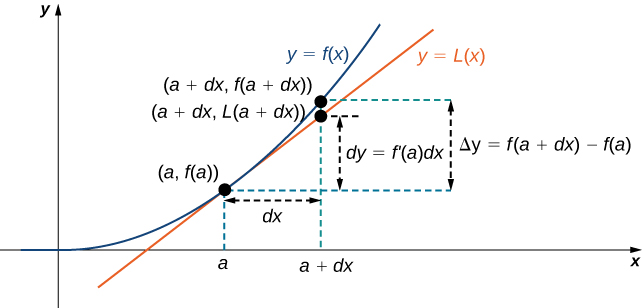Differentials and Amount of Error
Computing Differentials
We have seen that linear approximations can be used to estimate function values. They can also be used to estimate the amount a function value changes as a result of a small change in the input. To discuss this more formally, we define a related concept: differentials. Differentials provide us with a way of estimating the amount a function changes as a result of a small change in input values.
When we first looked at derivatives, we used the Leibniz notation [latex]dy/dx[/latex] to represent the derivative of [latex]y[/latex] with respect to [latex]x[/latex]. Although we used the expressions [latex]dy[/latex] and [latex]dx[/latex] in this notation, they did not have meaning on their own.
Here we see a meaning to the expressions [latex]dy[/latex] and [latex]dx[/latex]. Suppose [latex]y=f(x)[/latex] is a differentiable function. Let [latex]dx[/latex] be an independent variable that can be assigned any nonzero real number, and define the dependent variable [latex]dy[/latex] by
It is important to notice that [latex]dy[/latex] is a function of both [latex]x[/latex] and [latex]dx[/latex]. The expressions [latex]dy[/latex] and [latex]dx[/latex] are called differentials.
We can divide both sides of the equation by [latex]dx[/latex], which yields
This is the familiar expression we have used to denote a derivative. The first equation is known as the differential form of the second one.
differentials
Differentials, denoted as [latex]dy[/latex] and [latex]dx[/latex], provide a method to estimate the rate of change of a function [latex]y=f(x)[/latex] due to a small change in [latex]x[/latex].
By representing the derivative [latex]\frac{dy}{dx}=f^{\prime}(x)[/latex] in terms of differentials, [latex]dy[/latex] can be understood as the change in [latex]y[/latex] resulting from an infinitesimal increment [latex]dx[/latex] in [latex]x[/latex].
For each of the following functions, find [latex]dy[/latex] and evaluate when [latex]x=3[/latex] and [latex]dx=0.1[/latex].
- [latex]y=x^2+2x[/latex]
- [latex]y= \cos x[/latex]
We now connect differentials to linear approximations. Differentials can be used to estimate the change in the value of a function resulting from a small change in input values.
Consider a function [latex]f[/latex] that is differentiable at point [latex]a[/latex]. Suppose the input [latex]x[/latex] changes by a small amount. We are interested in how much the output [latex]y[/latex] changes. If [latex]x[/latex] changes from [latex]a[/latex] to [latex]a+dx[/latex], then the change in [latex]x[/latex] is [latex]dx[/latex] (also denoted [latex]\Delta x[/latex]), and the change in [latex]y[/latex] is given by
Instead of calculating the exact change in [latex]y[/latex], however, it is often easier to approximate the change in [latex]y[/latex] by using a linear approximation.
For [latex]x[/latex] near [latex]a[/latex], [latex]f(x)[/latex] can be approximated by the linear approximation
Therefore, if [latex]dx[/latex] is small,
That is,
In other words, the actual change in the function [latex]f[/latex] if [latex]x[/latex] increases from [latex]a[/latex] to [latex]a+dx[/latex] is approximately the difference between [latex]L(a+dx)[/latex] and [latex]f(a)[/latex], where [latex]L(x)[/latex] is the linear approximation of [latex]f[/latex] at [latex]a[/latex]. By definition of [latex]L(x)[/latex], this difference is equal to [latex]f^{\prime}(a)dx[/latex].
In summary,
Therefore, we can use the differential [latex]dy=f^{\prime}(a) \, dx[/latex] to approximate the change in [latex]y[/latex] if [latex]x[/latex] increases from [latex]x=a[/latex] to [latex]x=a+dx[/latex]. We can see this in the following graph.

We now take a look at how to use differentials to approximate the change in the value of the function that results from a small change in the value of the input. Note the calculation with differentials is much simpler than calculating actual values of functions and the result is very close to what we would obtain with the more exact calculation.
Let [latex]y=x^2+2x[/latex].
Compute [latex]\Delta y[/latex] and [latex]dy[/latex] at [latex]x=3[/latex] if [latex]dx=0.1[/latex].